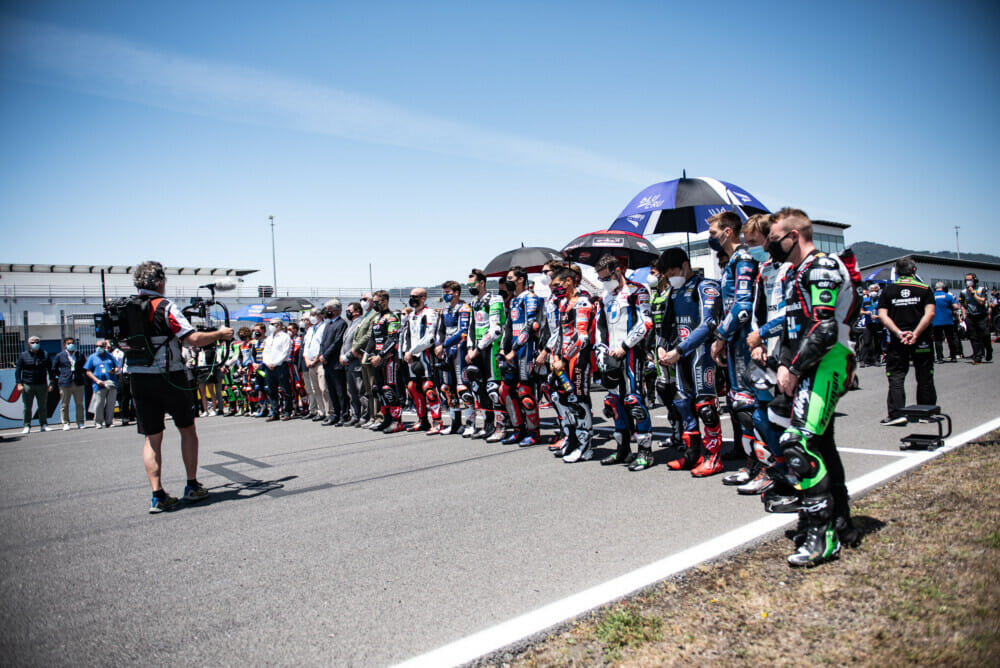Michael Scott | June 9, 2021
Cycle News In The Paddock
COLUMN
Not A Good Afternoon
An unexpected feeling came in the aftermath of the death of Moto3 rider Jason Dupasquier at Mugello, the obvious shock tempered with a bizarre kind of relief.
Thankfully, only one victim.
So often already this year, it could have been worse.
The dread has been growing over the past seasons, most acutely in a Moto3 class which seems to become exponentially closer and at the same time ever more reckless year by year.
 MotoGP and WorldSBK (here) both held one of minute silence in honor of Dupasquier.
MotoGP and WorldSBK (here) both held one of minute silence in honor of Dupasquier.
Gangs of 15 or more desperate teenagers circulate on the ragged edge—at the giddy limit, and within touching distance. TV commentators sometimes call these tactical battles “high-speed games of chess.”
Not appropriate in spite of the obvious tactics entailed. They are more like skittles.
One down and it’s pure chance if he doesn’t take several more with him.
And it does happen, quite often. At which point, the results are down to pure blind luck. As always, once a rider is bouncing on solid ground at high speed—and all the more so when there are several of them—with a mass of out-of-control motorcycles going with them.
Luck that ran out for the Swiss teenager at Mugello.
Aged 19 and son of a bike-racing father, Dupasquier was in his second Moto3 season, and making a good impression. He earned his first points with 10th in round one, and had scored in every race so far, to lie 12th overall on the Pruestel CarXpert KTM.
He was in Q2 again, as at every race this year bar one, and placed 11th in the closing minutes of Q2 when he ran off line to avoid another rider, touched the paint on the outside of the fast Arrabbiata Two corner.
He fell in such a way that he was hit by at least one following rider, sustaining severe head and other injuries.
This is almost always how fatalities occur. Of the past four in GP racing—Shoya Tomizawa (2010), Marco Simoncelli (2011), Luis Salom (2016) and Dupasquier (2021)—three were because the fallen rider was struck by following bikes. This is one circumstance that all the safety equipment cannot mitigate.
It is remarkable, however, to measure just how much safer World Championship racing is nowadays. This is thanks in large part to better crash helmets and clothing, rider airbags and back protectors, and also to better medical intervention.
More than any other factor, it is thanks to safer tracks—the worst of them simply abandoned, others subject to enforced modifications such as revised layouts, improved run-off, air-fences and more. At first in response to rider pressure and recently thanks to the rigor of Dorna.
It is noteworthy how the World Championship death toll fell sharply after the Isle of Man TT was taken off the calendar in 1976. This was followed, gradually, by other notoriously dangerous circuits, like Spa Francorchamps and Austria’s super-scary Salzburgring.
A run through Wikipedia’s epitaph of 104 names of grand prix victims (including sidecar drivers and passengers) is most revealing. In the first decade, from 1949 to 1958, there were 31 deaths. The next decade, 25, from 1969 to 1978 27. An average of almost three riders lost every year.
Thereafter, only 13 between 1979 and 1988, and since then just a smattering. The next three decades together recorded seven deaths, and now in 2021 one more.
No wonder what was once regarded as a normal hazard now occasions such a shock. Brutal notification of how the serious dangers of motorcycle racing comes so seldom that it is easy to forget and make light of it in the interim.
When the victim is still in his teens, when any parent can feel the agony even at second hand, the shock is all the more severe. And likewise, to his peers and his on-track rivals. The “it couldn’t happen to me” feeling nullified at a stroke.
Then comes the why-oh-why. The feeling that somehow these daredevils should be protected from themselves, that if the teenage brain has not yet developed risk-averse strategies, then adults should step in to take responsibility.
This tempting argument, however, doesn’t hold water. These Moto3 kids are much better off engaged in professional motorcycle racing, fully supervised and with first-class medical attendance on first-class tracks than they would be out taking freelance risks, tomb-stoning, after-dark parkour, base-jumping, etc.
There was inevitably a lot of posturing on the dark day that Dupasquier’s fate was confirmed as racing got under way on Sunday. A lot of dedications of rostrum finishes and post-race pointing at the sky, probably comforting and definitely sincere. The tributes continued the following weekend at Catalunya.
As often, it was Miguel Oliveira whose heartfelt but matter-of-fact comment summed it up best. “I wish this sport could not be so cruel…but it is our passion.” CN
Click here for all the latest MotoGP news.